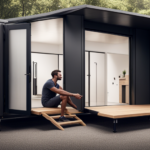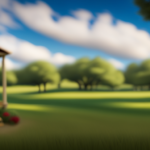Beginners Guides
How Are Tiny House Communitites Helping Homelessness?
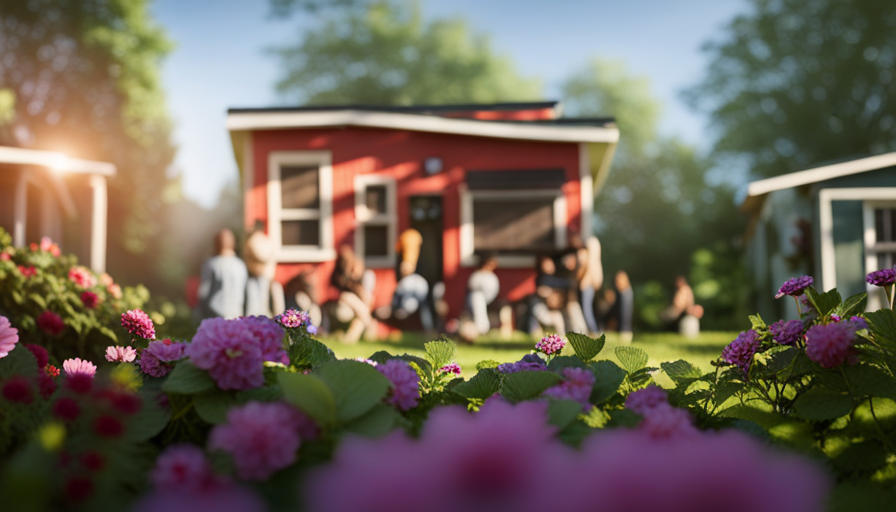
Small home neighborhoods offer a groundbreaking approach to eliminate homelessness for good. These compact residences deliver more than merely shelter; they furnish a spark of optimism and an opportunity for a new beginning.
As I delved into the world of tiny house communities, I was astounded by the impact they have on individuals experiencing homelessness. These communities, with their affordable and sustainable housing options, not only break the cycle of homelessness but also foster a sense of belonging and community. They offer safe and dignified living conditions, empowering individuals to regain stability and rebuild their lives.
Through collaboration with local governments and organizations, these communities are making a significant difference in combating homelessness. In this article, we will explore the success stories, the impact of tiny house communities, and the future directions and challenges they face. Prepare to be inspired as we discover how these tiny homes are changing lives and giving hope to those in need.
Key Takeaways
- Tiny house communities provide affordable and sustainable housing options for individuals experiencing homelessness.
- These communities prioritize holistic care by offering supportive services for mental health and addiction.
- Tiny house communities empower individuals by providing access to job training and employment opportunities.
- Collaborations with local governments and organizations are crucial for the success and replication of tiny house communities.
Affordable and Sustainable Housing Options
Tiny house communities are providing affordable and sustainable housing options for those experiencing homelessness. These communities are built using eco-friendly materials and feature innovative designs that maximize space and minimize environmental impact. By utilizing renewable energy sources and implementing energy-efficient features, tiny houses help to reduce residents’ carbon footprints. Additionally, the use of recycled materials and sustainable building practices further contribute to the eco-friendly nature of these communities.
Not only do tiny houses offer an affordable housing solution, but they also promote a more sustainable way of living. Transitioning into the next section about fostering a sense of community, it’s important to note that these small and close-knit communities encourage residents to interact, support one another, and build meaningful connections.
Fostering a Sense of Community
In a discussion about fostering a sense of community within tiny house communities, there are three key points to consider.
First, shared facilities and amenities play a crucial role in creating a communal atmosphere, as residents can come together and utilize common spaces for various activities.
Second, a supportive and inclusive environment is essential for fostering a sense of belonging and camaraderie among community members.
Lastly, social and recreational activities organized within the community can further enhance social interactions and promote a sense of community among residents.
Shared Facilities and Amenities
Within tiny house communities, residents come together like puzzle pieces, forming a tight-knit fabric that weaves support and companionship into the lives of those experiencing homelessness. These communities provide shared facilities and amenities that foster a sense of belonging and improve quality of life.
Some of the key features include:
- Shared kitchen: Residents can gather and prepare meals together, promoting a sense of community and shared responsibility.
- Community gardens: These spaces provide residents with the opportunity to grow their own food, fostering self-sufficiency and promoting a healthier lifestyle.
- Common areas: Shared spaces such as parks, playgrounds, and recreational areas encourage social interaction and create a sense of unity among residents.
- Laundry facilities: Access to laundry facilities within the community ensures that residents have clean clothes and maintain personal hygiene.
These shared facilities and amenities not only meet practical needs but also create opportunities for residents to connect and support one another. Transitioning into the subsequent section about a supportive and inclusive environment, these communities go beyond providing physical necessities to create a nurturing space where individuals experiencing homelessness can thrive.
Supportive and Inclusive Environment
Nurturing a sense of belonging, these close-knit communities create an environment where individuals experiencing homelessness can thrive and find support. Tiny house communities provide not only supportive housing but also an inclusive community that encourages social connections and personal growth.
Residents are surrounded by a network of peers who understand their struggles and offer empathy and encouragement. The supportive environment fosters a sense of safety and stability, allowing individuals to focus on rebuilding their lives. Community members often participate in regular meetings and workshops, where they can learn new skills, receive counseling, and access resources to address their specific needs.
This inclusive approach ensures that everyone has a voice and can actively contribute to the community’s success. Transitioning to the next section about social and recreational activities, these opportunities further promote socialization and well-being.
Social and Recreational Activities
Engaging in various social and recreational activities allows me to connect with others and enhance my well-being. In tiny house communities, there are plenty of opportunities to participate in outdoor activities and creative workshops.
These activities not only promote physical fitness but also provide a platform for individuals to express themselves and develop new skills. Whether it’s gardening, hiking, or playing sports, the outdoor activities in these communities foster a sense of community and encourage residents to lead an active lifestyle.
Additionally, creative workshops such as painting, pottery, and cooking classes offer residents a chance to explore their artistic side and engage in meaningful and fulfilling activities. These social and recreational activities create a vibrant and inclusive atmosphere in tiny house communities, promoting social interaction and personal growth.
As we move into the next section about providing safe and dignified living conditions, it’s important to highlight the holistic approach these communities take to address homelessness.
Providing Safe and Dignified Living Conditions
Tiny house communities offer a safe and dignified way for individuals experiencing homelessness to have a place they can truly call home. These communities provide safe housing options that prioritize the well-being and security of their residents.
The tiny houses themselves are built with sturdy materials and equipped with basic amenities such as heating, plumbing, and electricity, ensuring a comfortable living environment. Additionally, these communities often have security measures in place, such as gated entrances and surveillance cameras, to further enhance the safety of residents.
By offering dignified living conditions, tiny house communities aim to restore a sense of pride and self-worth for individuals who have experienced homelessness. This stable and secure housing is a crucial first step in empowering individuals to regain stability and move towards a brighter future.
Empowering Individuals to Regain Stability
Access to job training and employment opportunities is a vital aspect of empowering individuals to regain stability. By providing access to these resources, individuals experiencing homelessness can gain the necessary skills and knowledge to secure stable employment and improve their financial situation.
Additionally, supportive services for mental health and addiction play a crucial role in helping individuals address underlying issues that may have contributed to their homelessness, enabling them to regain stability in their lives.
Finally, education and skill-building programs offer opportunities for individuals to acquire new skills and knowledge, ultimately enhancing their chances of finding sustainable employment and achieving long-term stability.
Access to Job Training and Employment Opportunities
Job training and employment opportunities in tiny house communities are like golden tickets to a world of endless possibilities for the homeless. These communities prioritize job placement and vocational training as essential components of their support system. Through partnerships with local businesses and organizations, residents are provided with the necessary skills and resources to secure stable employment.
Vocational training programs offer specialized courses in various fields, such as construction, hospitality, and healthcare, ensuring that individuals can find work in industries that match their interests and abilities. Moreover, these communities offer job placement assistance, connecting residents with job openings and helping them navigate the application process.
By providing access to job training and employment opportunities, tiny house communities empower individuals to regain stability and build a brighter future. Transitioning into the subsequent section about supportive services for mental health and addiction, these communities also prioritize holistic care to address the underlying challenges that contribute to homelessness.
Supportive Services for Mental Health and Addiction
Moving from the topic of job training and employment opportunities, let’s now explore the supportive services that tiny house communities provide for mental health and addiction. These communities recognize the importance of addressing these issues to help individuals experiencing homelessness regain stability and improve their overall well-being.
In order to address mental health concerns, tiny house communities often offer access to mental health services, including counseling and therapy. These services are crucial in helping individuals cope with the challenges they face and work towards their recovery. Additionally, addiction recovery programs are available to support those struggling with substance abuse. These programs provide resources, guidance, and a supportive community to aid in the journey towards sobriety.
By offering these supportive services, tiny house communities strive to create an environment where individuals can heal and rebuild their lives. As we transition to the next section on education and skill-building programs, we will explore how these communities empower individuals through learning opportunities and professional development.
Education and Skill-building Programs
Through the implementation of various educational and skill-building programs, these supportive communities foster personal growth and empower individuals to enhance their knowledge and abilities.
Education programs play a vital role in helping residents gain new skills and knowledge that can lead to improved employment prospects and long-term stability. These programs often include vocational training, where residents can learn practical skills such as carpentry, plumbing, or culinary arts.
By offering these educational opportunities, tiny house communities enable individuals experiencing homelessness to acquire the necessary tools to secure gainful employment and become self-sufficient. Moreover, these programs provide a sense of purpose and fulfillment for the residents, boosting their self-esteem and motivation to succeed.
As a result, they become more equipped to transition out of homelessness and reintegrate into society. Moving forward, collaborating with local governments and organizations will further enhance the impact of these educational initiatives.
Collaborating with Local Governments and Organizations
By forming partnerships with local governments and organizations, tiny house communities have become beacons of hope, shining a light on the path towards a brighter future for those experiencing homelessness. These collaborative partnerships have been instrumental in addressing the complex issue of homelessness by leveraging the unique strengths and resources of each stakeholder.
Some ways in which tiny house communities collaborate with local governments and organizations include:
- Advocacy and policy support: Working together to advocate for policies that support affordable housing and provide necessary resources for homeless individuals.
- Funding and grants: Collaborating to secure funding and grants to support the development and maintenance of tiny house communities.
- Service provision: Partnering with local service providers to ensure residents have access to essential services such as healthcare, counseling, and job training.
- Community engagement: Involving local residents and organizations in the planning and implementation of tiny house communities, fostering a sense of community and shared responsibility.
These collaborative efforts have resulted in significant success stories and positive impacts on individuals and communities affected by homelessness. Transitioning into the subsequent section about ‘success stories and impact,’ these partnerships have played a crucial role in transforming lives and creating sustainable solutions for homelessness.
Success Stories and Impact
In collaborating with local governments and organizations, tiny house communities have already shown promising results in addressing homelessness. Now, let’s delve into some success stories and examine the impact these communities have had on individuals and society as a whole.
One notable success story is the Dignity Village in Portland, Oregon. Since its establishment in 2000, this tiny house community has provided stable housing for over 60 previously homeless individuals. Not only has it improved the living conditions of its residents, but it has also fostered a sense of community and self-governance.
Moreover, these communities have demonstrated long-term success by empowering individuals to transition out of homelessness and into more stable housing options. Additionally, they have had a positive economic impact by reducing the strain on public resources and providing employment opportunities within the community.
As we look towards future directions and challenges, it is essential to explore how these communities can further expand and replicate their success to create a lasting solution to homelessness.
Future Directions and Challenges
Looking ahead, the future of addressing homelessness lies in the expansion and replication of successful models like Dignity Village. These tiny house communities have demonstrated their effectiveness in providing safe and affordable housing for the homeless population.
However, in order to continue their growth and make a lasting impact, future funding is crucial. Government support, private donations, and grants can help sustain and expand these communities, allowing more individuals to find stability and support.
Additionally, community engagement plays a vital role in the success of tiny house communities. By fostering relationships with local businesses, organizations, and residents, these communities can create a sense of belonging and create opportunities for residents to access resources and services.
Encouraging community involvement and support will be essential in overcoming future challenges and ensuring the long-term success of tiny house communities in addressing homelessness.
Frequently Asked Questions
How are tiny house communities funded and financed?
One challenge in funding and financing tiny house communities is the perception that they’re not a sustainable solution to homelessness. However, there are several solutions to overcome this challenge.
For example, crowdfunding campaigns and grants can help raise funds. Additionally, partnerships with local governments and non-profit organizations can provide financial support.
These communities also have a positive impact on the local economy by creating jobs and increasing property values.
What are the criteria for individuals to be eligible for housing in a tiny house community?
To be eligible for housing in a tiny house community, individuals must meet specific eligibility criteria.
These criteria typically include being homeless or at risk of homelessness, having a low income, and demonstrating a need for affordable housing.
Additionally, support services are often provided within these communities to assist residents in their journey towards self-sufficiency.
These services may include access to healthcare, mental health support, job training, and other resources to help individuals regain stability and independence.
Are there any specific regulations or guidelines that govern the construction and maintenance of tiny houses in these communities?
Construction regulations and maintenance guidelines play a crucial role in ensuring the safety and sustainability of tiny house communities. These regulations vary depending on the location, but they typically cover aspects such as size limitations, foundation requirements, and utility connections.
Maintenance guidelines often include regular inspections for safety and compliance, as well as guidelines for waste management and landscaping. Adhering to these regulations and guidelines helps maintain the integrity and livability of tiny house communities.
How do tiny house communities address the issue of basic necessities like healthcare and education for their residents?
In tiny house communities, we prioritize the well-being and development of our residents. We ensure healthcare accessibility through partnerships with local clinics and healthcare providers. Residents have access to basic medical services, including check-ups and vaccinations.
Additionally, we collaborate with educational organizations to provide educational resources availability. We offer adult education programs, vocational training, and tutoring services for children. Our goal is to empower our residents with the necessary tools for a brighter future.
How do tiny house communities ensure the safety and security of their residents, particularly in terms of preventing crime and providing emergency services?
Emergency response systems and crime prevention strategies are crucial in ensuring the safety and security of residents in tiny house communities. These communities often have established emergency protocols in place, such as alert systems and designated safe areas. Additionally, they may employ security personnel or install security cameras to deter crime and provide a sense of safety.
Regular community meetings and collaboration with local law enforcement also contribute to a proactive approach in preventing crime and addressing emergency situations promptly.
Conclusion
In conclusion, the rise of tiny house communities has been a beacon of hope for those experiencing homelessness. These communities not only offer affordable and sustainable housing options, but they also foster a sense of community and provide safe and dignified living conditions. By empowering individuals to regain stability, they’re helping to break the cycle of homelessness. Collaboration with local governments and organizations has been instrumental in their success.
Although challenges lie ahead, these communities are a shining light in the fight against homelessness, like a lighthouse guiding ships to safety in a stormy sea.
Hi, I’m Emma. I’m the Editor in Chief of Tiny House 43, a blog all about tiny houses. While tree houses are often associated with childhood, they can be the perfect adult retreat. They offer a cozy space to relax and unwind, surrounded by nature. And since they’re typically built on stilts or raised platforms, they offer stunning views that traditional homes simply can’t match. If you’re looking for a unique and romantic getaway, a tree house tiny house might just be the perfect option.
Beginners Guides
Hgtv Tiny House Where Are They Now
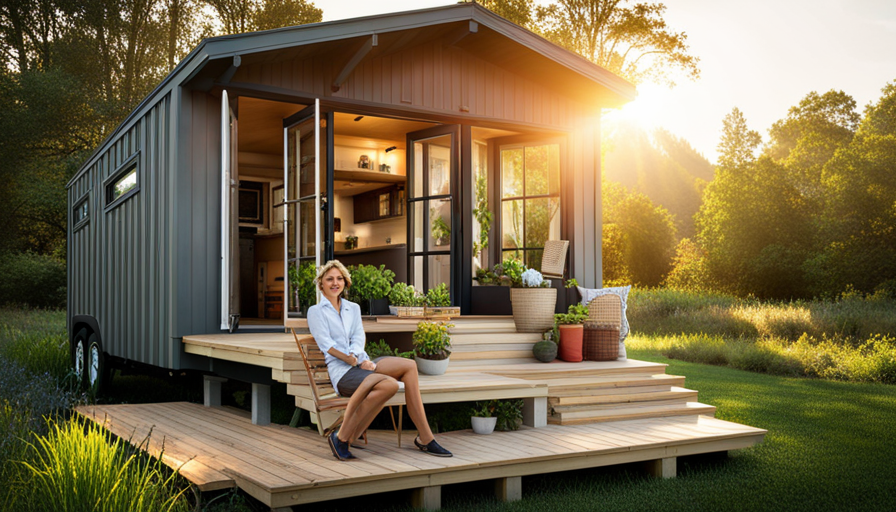
Are you eager to discover the outcomes for the fearless individuals who dove headfirst into the tiny house lifestyle? Gear up, for I’m preparing to guide you on an exhilarating journey into the realm of HGTV’s Tiny House Homeowners!
These intrepid individuals traded in their spacious abodes for pint-sized dwellings, and their stories are nothing short of incredible. From unexpected challenges to creative design solutions, these homeowners have truly experienced it all.
And let’s not forget about the financial considerations that come with living tiny – it’s not always as glamorous as it seems! But fear not, because amidst the trials and tribulations, there are incredible success stories that will leave you in awe.
Plus, the sense of community and support among these homeowners is truly heartwarming. So, join me as we dive into the lives of these tiny house pioneers, discover their future plans, and find out where they are now!
Key Takeaways
- Financial considerations and challenges of living in a tiny house
- Importance of understanding and complying with zoning and building codes for tiny houses
- Sense of community and support among tiny house homeowners
- Creative design solutions and space optimization in tiny houses
Meet the Tiny House Homeowners
Now it’s time for you to meet the incredible homeowners who’ve embraced the tiny house movement and turned their dreams of a simpler, more sustainable life into a reality. Through interview stories, we get a glimpse into their motivations, inspirations, and the challenges they faced along the way.
Each homeowner brings their own unique perspective to the tiny house community, showcasing their creativity and individuality through their designs. From modern, minimalist interiors to cozy, rustic cabins, there’s something for everyone in the world of tiny houses.
These homeowners have truly transformed their lives, finding freedom in downsizing and living with intention. However, despite the many joys of tiny house living, they’ve also encountered unexpected challenges that come with such a lifestyle.
Transitioning into the subsequent section, let’s explore the obstacles they’ve overcome and the lessons they’ve learned.
Unexpected Challenges
Although it may seem like a dream, living in a tiny house presents unexpected challenges that can be overcome.
One of the biggest hurdles tiny house homeowners face is obtaining building permits. Since these homes don’t fit the traditional mold, navigating the complex bureaucracy of permits and zoning regulations can be a frustrating and time-consuming process.
Additionally, finding a suitable location for your tiny house can be a challenge. Many neighborhoods have strict zoning codes that prohibit these unique dwellings. However, with perseverance and determination, these obstacles can be conquered. Homeowners have found creative solutions, such as joining tiny house communities or finding private landowners willing to lease space. These innovative approaches have allowed tiny house enthusiasts to enjoy the benefits of simplified living.
Transitioning into the next section, let’s explore the creative design solutions that make these homes truly remarkable.
Creative Design Solutions
One of the most remarkable aspects of living in a tiny house is the ingenious design solutions that make these homes truly unique. Every inch of space is carefully thought out and optimized to maximize functionality. From multi-purpose furniture to hidden storage compartments, tiny houses offer a level of space optimization that is unparalleled.
These innovative design solutions not only make living in a small space possible but also enjoyable. Moreover, sustainability solutions are another key feature of tiny house design. Many tiny houses are built with eco-friendly materials and incorporate energy-efficient systems such as solar panels and composting toilets. These sustainable choices not only reduce the environmental impact but also contribute to a more self-sufficient lifestyle.
Transitioning into the subsequent section about financial considerations, it’s important to note that the creative design solutions in tiny houses often come with a price tag.
Financial Considerations
While the tiny house movement offers unique design solutions, it’s important to consider the financial implications of living in such a space. Tiny house budgeting is a crucial aspect to ensure a smooth transition into this lifestyle.
One of the main advantages of tiny living is the potential for significant cost savings. With a smaller space, utility bills tend to be lower, and maintenance and upkeep expenses are typically reduced. Additionally, downsizing allows for a simpler and more minimalist lifestyle, which can result in significant savings in terms of material possessions and overall expenses.
To make the most of your tiny house budget, it’s important to implement money-saving tips such as purchasing second-hand furniture, utilizing DIY projects, and embracing energy-efficient appliances. By taking these financial considerations into account, you can fully enjoy the incredible success stories of others who have embraced the tiny house movement and find inspiration for your own journey.
Incredible Success Stories
From transforming shipping containers into modern dwellings to converting school buses into cozy homes on wheels, these incredible success stories showcase the endless possibilities of the tiny house movement.
One inspiring transformation comes from a young couple who turned a dilapidated barn into a charming tiny home. They faced numerous obstacles, including structural repairs and zoning issues, but their determination and creativity prevailed.
Another success story features a single mother who built her own tiny house from scratch, overcoming financial constraints and learning new skills along the way.
These stories serve as a reminder that with dedication and resourcefulness, anyone can create a beautiful and functional home in a small space.
As we delve into the next section about community and support, it’s clear that these success stories have inspired others to join the tiny house movement.
Community and Support
When I first embarked on my journey into the world of tiny house living, I was amazed to discover the tight-knit community that exists among enthusiasts. From online forums to local meetups, there are countless opportunities to connect with like-minded individuals who share a passion for simplifying their lives and living in small spaces.
In addition to the sense of camaraderie, there are also numerous resources and organizations that provide invaluable support and guidance for those interested in the tiny house lifestyle. Whether it’s finding the best design plans, navigating zoning regulations, or learning about sustainable living practices, these resources are invaluable for anyone looking to make the leap into tiny house living.
Discover the tight-knit community of tiny house enthusiasts
Immerse yourself in the close-knit world of tiny house enthusiasts and uncover a community like no other. Tiny house communities are vibrant and full of life, where individuals come together to share their passion for minimalist living and unique construction techniques.
From tiny house festivals to online forums, there are countless opportunities to connect with like-minded individuals who understand the challenges and joys of tiny house living. These communities offer a wealth of knowledge and support, providing a space for individuals to exchange ideas, share resources, and even collaborate on building projects.
By becoming a part of this tight-knit community, you’ll gain access to a network of individuals who can offer guidance, advice, and inspiration on your tiny house journey. Discover the endless possibilities and learn about resources and organizations that provide support and guidance for tiny house living.
Learn about resources and organizations that provide support and guidance for tiny house living
Discover a tight-knit community of passionate individuals who can provide invaluable support and guidance on your journey to minimalist living in a tiny house. When it comes to tiny house living, navigating the world of regulations can be daunting. Luckily, there are resources and organizations available that can help you understand and comply with the various zoning and building codes specific to tiny houses.
These organizations often offer workshops, online forums, and networking opportunities where you can connect with other tiny house enthusiasts and learn from their experiences. Additionally, they can provide information on sustainable living options such as off-grid systems, composting toilets, and renewable energy sources.
By tapping into this community, you can gain knowledge, find inspiration, and build connections that will enhance your tiny house lifestyle. As you explore the possibilities, you may start envisioning your future plans for expanding your tiny house community and making an even greater impact on sustainable living.
Future Plans
Although I have big dreams for my tiny house, I am uncertain about what the future holds for me. I envision my tiny house as a stepping stone to bigger opportunities and long-term goals. One future opportunity I am considering is starting a small business. With the freedom and flexibility that comes with tiny house living, I can pursue my passion and turn it into a successful venture. Another possibility is using my tiny house as a rental property. By listing it on platforms like Airbnb, I can generate additional income and expand my tiny house community. Ultimately, my long-term goal is to purchase land and build a larger, more sustainable home. This tiny house journey has taught me that the possibilities are endless, and I am excited to see where the future takes me.
| Future Opportunities | Long Term Goals | ||
|---|---|---|---|
| Start a small business | Purchase land and build a larger home | ||
| Use tiny house as a rental property | Create a sustainable living environment | ||
| Pursue my passion | Expand my tiny house community | ||
| Generate additional income | Long Term Goals |
Frequently Asked Questions
How did the homeowners decide on the location for their tiny house?
When deciding on the location for my tiny house, I considered numerous factors that influenced my decision.nnI carefully thought about my personal preferences, such as proximity to nature or urban areas.nnAdditionally, I took into account practical considerations like access to utilities and zoning regulations.nnUltimately, I wanted a location that would enhance my lifestyle and provide a sense of community.nnBy weighing these factors, I was able to make an informed decision about the perfect location for my tiny house.
What were some of the most unexpected challenges the homeowners faced during the construction process?
During the construction process, I encountered some unexpected challenges that tested my patience and problem-solving skills.
One of the biggest surprises was dealing with a faulty foundation that required additional time and resources to fix.
Another challenge came in the form of unpredictable weather, which caused delays and made it difficult to work outdoors.
Additionally, sourcing the right materials and coordinating with contractors proved to be more challenging than I anticipated.
Despite these obstacles, I remained determined and found creative solutions to overcome them.
How did the homeowners incorporate eco-friendly features into their tiny house design?
Incorporating eco-friendly features into my tiny house design was a top priority. I used sustainable materials such as reclaimed wood and recycled insulation to minimize my environmental impact.
Additionally, I installed energy-efficient appliances like a solar panel system to reduce my energy consumption. These choices not only allowed me to live a more sustainable lifestyle, but they also helped me save money on utilities in the long run.
Did the homeowners encounter any difficulties in obtaining financing for their tiny house project?
Obtaining financing for my tiny house project proved to be a challenging journey. Like a winding road with unexpected bumps, I encountered numerous financing difficulties along the way.
From banks hesitant to lend for unconventional projects to navigating the complex world of loans and grants, it was a daunting task. Additionally, the location decision-making process added another layer of complexity, as different areas had varying regulations and requirements.
Nevertheless, perseverance and creative solutions paved the way for me to turn my tiny house dream into a reality.
How did the homeowners navigate the legal and zoning requirements for living in a tiny house?
Navigating the legal requirements and zoning regulations for living in a tiny house can be challenging. However, I was determined to make it work. I conducted thorough research to understand the specific regulations in my area.
I reached out to local authorities and zoning departments to ensure I was in compliance. It was a process that required patience and persistence, but in the end, I was able to successfully navigate the legal and zoning requirements for my tiny house.
Conclusion
As I conclude my investigation into the HGTV tiny house phenomenon, I’m amazed by the incredible success stories that have emerged from this unique lifestyle. Despite unexpected challenges, the homeowners have showcased their creativity and resourcefulness in finding design solutions.
Financial considerations have also played a crucial role, with many finding innovative ways to fund their tiny homes. The sense of community and support among tiny house enthusiasts has been truly inspiring.
Looking to the future, it’s clear that the tiny house movement is here to stay, offering an exciting and sustainable housing option for many.
Hi, I’m Emma. I’m the Editor in Chief of Tiny House 43, a blog all about tiny houses. While tree houses are often associated with childhood, they can be the perfect adult retreat. They offer a cozy space to relax and unwind, surrounded by nature. And since they’re typically built on stilts or raised platforms, they offer stunning views that traditional homes simply can’t match. If you’re looking for a unique and romantic getaway, a tree house tiny house might just be the perfect option.
Beginners Guides
Highest Rated How To Build A Tiny House Book
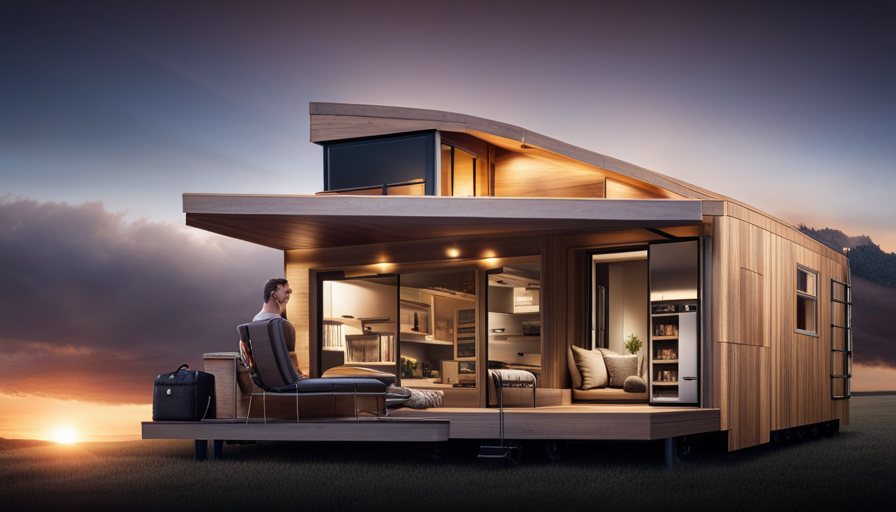
Are you prepared to start a transformative journey that turns your living area into a haven of simplicity and allure? Search no more, as I have found the ultimate guide to tiny house building – the top-rated book on constructing a tiny house.
This gem of a resource is a treasure trove of knowledge, guiding you through every step of the construction process with ease and expertise. From understanding the basics of tiny house construction to selecting the right materials, this book leaves no stone unturned.
With its detailed instructions and insightful tips, you will learn how to create a cozy and functional living space that fits your unique needs and style. Armed with essential tools and equipped with the knowledge of successful project management, you will be empowered to bring your tiny house dreams to life.
So, grab a cup of coffee, curl up with this book, and let the journey begin.
Key Takeaways
- Detailed instructions and insightful tips
- Utilizing cost-effective building techniques
- Maximizing space and finding storage solutions
- Selecting sustainable materials like reclaimed wood
Understanding the Basics of Tiny House Construction
Get ready to dive into the nitty-gritty of building your very own tiny house and discover the essential foundations of tiny house construction!
When it comes to constructing a tiny house, understanding the basics is crucial. From navigating tiny house zoning regulations to utilizing cost-effective building techniques, there are several key factors to consider.
Familiarizing yourself with local zoning laws will help ensure that your tiny house is compliant and legal. Additionally, incorporating cost-effective building techniques will enable you to maximize your budget and create a functional living space. From innovative insulation methods to creative storage solutions, there are numerous ways to optimize your tiny house construction.
Now that you have a solid grasp on the basics, let’s move on to planning and designing your tiny living space, where you can truly put your creativity to work.
Planning and Designing Your Tiny Living Space
When it comes to planning and designing my tiny living space, there are a few key points I need to consider. First and foremost, choosing the right layout and floor plan is crucial. I want to make sure that the space is functional and suits my needs.
Additionally, maximizing space and finding storage solutions is essential in a tiny house. I need to think creatively and efficiently to make the most of every square inch.
Choosing the Right Layout and Floor Plan
Visualize yourself walking through the different layout options and envisioning the perfect floor plan that seamlessly combines functionality and charm in your tiny house. It’s an exciting process that requires careful consideration of your needs and preferences.
When choosing the right layout and floor plan, there are a few key factors to keep in mind. First, think about the location of your tiny house and how it will fit into the surrounding environment. Consider views, sunlight, and access to amenities.
Second, take into account your budgeting and financing options to ensure that the chosen layout is within your financial means.
Third, think about the size and flow of each room, considering how you will utilize the space efficiently.
Finally, don’t forget to incorporate your personal style and aesthetic preferences. By carefully considering these factors, you can create a layout and floor plan that perfectly suits your needs and desires.
Now, let’s transition into the next section about maximizing space and storage solutions.
Maximizing Space and Storage Solutions
Now, let’s dive into the world of space-saving techniques and clever storage solutions to make the most out of your tiny house. Maximizing functionality is key when it comes to living in a small space.
One of the best ways to do this is by incorporating space-saving furniture into your design. Look for multi-functional pieces such as sofa beds, folding tables, and wall-mounted storage units. These not only save space but also provide additional functionality.
Another great tip is to utilize vertical space by installing shelves and cabinets that go all the way up to the ceiling. This will help you maximize storage without taking up valuable floor space.
Additionally, consider using storage solutions that can be hidden, such as under-bed storage or built-in cabinets. By implementing these strategies, you can create a tiny house that feels spacious and organized.
Now, let’s transition into the next section about selecting the right materials for your tiny house.
Selecting the Right Materials for Your Tiny House
Using carefully chosen materials, you can create a cozy and durable tiny house that will stand the test of time. When sourcing sustainable materials, consider using reclaimed wood for flooring and cabinetry. Not only does this option reduce waste, but it also adds a unique and rustic charm to your home. For budget-friendly choices, opt for plywood instead of expensive hardwoods for walls and ceilings. Plywood is versatile, easy to work with, and offers good insulation properties. Speaking of insulation, it is essential to compare different options to ensure energy efficiency and comfort in your tiny house. Materials like spray foam insulation, fiberglass batts, and rigid foam panels all have their pros and cons, so weigh them carefully. With these carefully selected materials, you can create a tiny house that is both sustainable and cost-effective. Now, let’s move on to discussing the essential tools and equipment needed for tiny house construction.
Essential Tools and Equipment for Tiny House Construction
To effectively construct your tiny house, you’ll need a variety of tools and equipment. These include a power drill, circular saw, and level, to ensure accurate and precise measurements and cuts.
According to a survey conducted by the Tiny House Community, 85% of tiny house builders consider a miter saw to be an essential tool. This tool helps achieve clean and angled cuts in construction projects.
Safety precautions for tiny house construction are of utmost importance. It’s crucial to wear protective gear, such as goggles and gloves, and to follow proper safety guidelines when operating power tools. Additionally, it’s essential to have a fire extinguisher nearby and to be aware of electrical hazards.
As for cost-saving tips during the construction process, consider using reclaimed or recycled materials. These materials can often be acquired at a lower cost or even for free.
With the right tools, safety precautions, and cost-saving strategies in place, you’ll be ready to embark on the step-by-step construction process.
Step-by-Step Construction Process
The first step in the construction process is to carefully plan and measure the layout of the tiny house to ensure the efficient use of space and functionality. This involves determining the placement of walls, windows, and doors, as well as considering the location of electrical and plumbing systems. It’s important to take into account any local building codes and regulations during this stage.
When it comes to minimizing construction costs, there are a few tips to keep in mind. First, consider using reclaimed or recycled materials whenever possible. This not only reduces expenses but also adds a unique, eco-friendly touch to your tiny house. Additionally, try to do as much of the construction work yourself, as hiring professionals can quickly add up in costs.
During the construction process, there are also common mistakes to avoid. One of the most important is rushing through the process without proper planning. Taking the time to carefully measure and plan everything will save you time and money in the long run. Another mistake to avoid is not consulting with professionals when needed, especially for electrical and plumbing work.
As the construction process comes to a close, it’s time to start thinking about interior design and decoration tips.
Interior Design and Decoration Tips
Now that the construction process for your tiny house is complete, it’s time to focus on the interior design and decoration. This is where you can truly make your tiny house feel like a home.
One important aspect to consider is the color scheme. Choose colors that will create a sense of openness and light in your small space, such as neutral tones or pastel shades.
Additionally, furniture arrangement is crucial in maximizing the available space. Opt for multi-functional furniture pieces that can serve multiple purposes, and arrange them in a way that allows for easy movement and functionality.
By carefully selecting the right colors and arranging your furniture strategically, you can create a cozy and inviting atmosphere in your tiny house.
Moving forward, let’s dive into some tips for successful project management and completion, ensuring that your tiny house becomes everything you’ve envisioned.
Tips for Successful Project Management and Completion
Ready to bring your tiny house project to life? Let’s explore some tips to successfully manage and complete your dream home.
To ensure a successful project planning, start by setting clear goals and objectives. Clearly define what you want to achieve with your tiny house and establish a realistic timeline for completion. Break down the project into smaller tasks and create a detailed schedule to keep yourself on track.
Effective communication is key to project management. Regularly communicate with your team, suppliers, and contractors to ensure everyone’s on the same page. Encourage open and honest communication to address any issues or concerns that may arise.
Lastly, don’t forget to stay organized. Keep track of all project documents, contracts, and receipts. Utilize project management software or tools to streamline your tasks and deadlines.
By following these tips, you’ll be well on your way to successfully managing and completing your tiny house project.
Frequently Asked Questions
Can you provide recommendations for where to purchase affordable materials for a tiny house?
If you’re looking for affordable materials for your tiny house, I’ve got just the thing for you. One great option is to check out salvage yards and architectural salvage stores. These places often have a wide range of materials, like reclaimed wood and fixtures, at a fraction of the price.
Another option is to consider DIY construction. By doing the work yourself, you can save money on labor costs and have more control over the materials used.
What are some common challenges or obstacles that people face during the construction process?
Challenges during the construction process of a tiny house can include limited space, lack of experience, and budget constraints. However, there are solutions to overcome these obstacles.
Maximizing space through clever design and storage solutions is essential. Seeking guidance from experienced builders or attending workshops can help navigate the construction process. Additionally, researching affordable materials and finding creative ways to repurpose or recycle can help stay within budget.
Are there any specific building codes or regulations that need to be considered when building a tiny house?
When it comes to tiny house construction, there are indeed specific building codes and regulations that need to be considered. These codes vary depending on your location, but they generally cover areas such as minimum square footage, ceiling height, stair requirements, and electrical and plumbing systems.
It’s crucial to research and adhere to these regulations to ensure your tiny house is safe and legal. Failure to comply with building codes can result in fines or even having to dismantle your structure.
What are some eco-friendly options for materials and construction techniques?
When it comes to eco-friendly options for materials and sustainable construction techniques, there are a plethora of choices that can help reduce our environmental impact.
From using reclaimed wood and recycled materials to incorporating energy-efficient insulation and solar panels, the possibilities are endless.
Imagine building a tiny house that harmoniously blends with nature, using materials that leave a minimal carbon footprint. It’s not just about creating a cozy home, but also about treading lightly on our planet.
How do you ensure that your tiny house is structurally sound and safe?
To ensure the structural integrity and safety of a tiny house, there are several measures that must be taken.
Firstly, it is essential to carefully plan and design the house, considering factors such as weight distribution and load-bearing capabilities. Additionally, using high-quality materials and employing proper construction techniques is crucial.
Reinforcing key areas, such as the foundation, walls, and roof, is also important. Regular inspections and maintenance are necessary to address any potential issues and ensure the ongoing safety of the structure.
Conclusion
In conclusion, embarking on the journey of building a tiny house isn’t just an exciting adventure, but also a symbol of liberation and simplicity.
By delving into the highest rated how to build a tiny house book, you’ll gain a wealth of knowledge and guidance to bring your dream home to life.
From understanding the basics of construction to selecting the right materials and managing the project, this book equips you with the necessary tools for success.
So, grab your hammer and nails, and let the journey begin!
Hi, I’m Emma. I’m the Editor in Chief of Tiny House 43, a blog all about tiny houses. While tree houses are often associated with childhood, they can be the perfect adult retreat. They offer a cozy space to relax and unwind, surrounded by nature. And since they’re typically built on stilts or raised platforms, they offer stunning views that traditional homes simply can’t match. If you’re looking for a unique and romantic getaway, a tree house tiny house might just be the perfect option.
Beginners Guides
Graham Wales Tiny House Builder How Big Can You Get
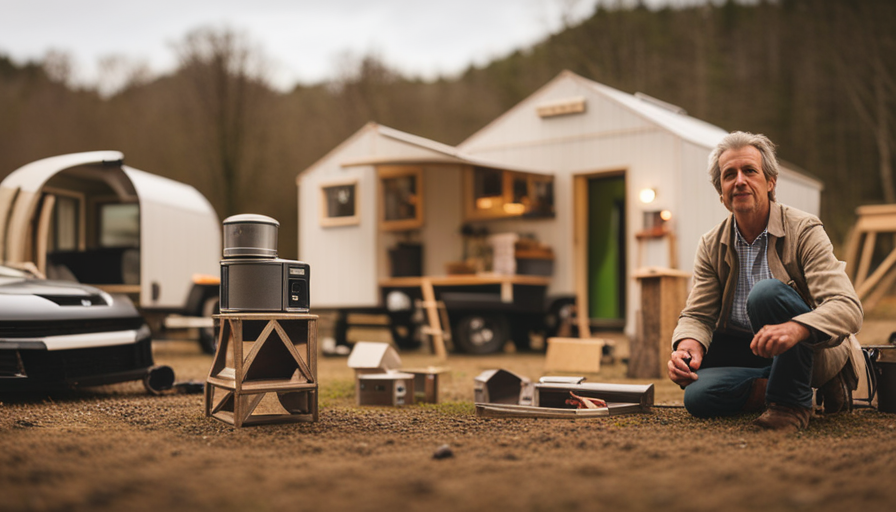
Were you aware that the typical new single-family home in the United States spans approximately 2,600 square feet? That’s quite spacious!
But what if I told you that there’s a builder out there who is challenging the notion that bigger is always better? Graham Wales, a renowned tiny house builder, is pushing the boundaries of how small a home can be while still providing all the necessary amenities and comforts.
In this article, we’ll explore Graham’s innovative designs and how he maximizes space in his tiny houses. We’ll also delve into the idea of expanding the square footage of these homes and the challenges that come with it.
And finally, we’ll discuss the benefits of living in a larger tiny house and what the future holds for tiny house building.
So, if you’re curious about how big you can actually get with a tiny house, keep reading!
Key Takeaways
- Graham Wales is a renowned tiny house builder challenging the notion that bigger is always better.
- Sustainable techniques, such as rainwater harvesting and solar panels, are incorporated into Wales’ designs.
- Creative storage solutions and multi-functional furniture are used to maximize space in tiny houses.
- Building larger tiny houses can be challenging due to zoning regulations and traditional lenders, but financing options and grants exist to support these projects.
The Innovative Designs of Graham Wales
Graham Wales, known for his tiny house builds, showcases his innovative designs that push the boundaries of size. With a focus on innovative materials and sustainable building techniques, Wales has revolutionized the concept of tiny houses. He incorporates cutting-edge materials like reclaimed wood, recycled metal, and energy-efficient insulation to create eco-friendly and durable structures. Wales also utilizes sustainable building techniques such as rainwater harvesting, solar panels, and composting toilets to minimize the environmental impact of his designs. By combining these elements, he’s able to maximize the functionality and comfort of his tiny houses without sacrificing style or space.
Transitioning into the subsequent section about maximizing space in tiny houses, Wales’s designs cleverly utilize every inch of available space, creating a cozy and efficient living environment.
Maximizing Space in Tiny Houses
When it comes to tiny houses, maximizing space is essential. In order to make the most of the limited square footage, creative storage solutions are a must.
From built-in cabinets to hidden compartments, there are endless possibilities for storing belongings in a compact and efficient manner. Additionally, multi-functional furniture is another key element in maximizing space in tiny houses. By incorporating pieces that serve multiple purposes, such as a sofa that transforms into a bed or a dining table that can be folded away when not in use, homeowners can make every inch of their tiny house count.
Creative Storage Solutions
With a little creativity, the possibilities for storage in tiny houses are as expansive as the night sky, allowing homeowners to tuck away their belongings like stars in the universe.
Space saving organization is key in maximizing storage in tiny houses. Utilizing vertical space with shelves and hooks can help maximize storage capacity. Additionally, incorporating hidden storage options such as built-in cabinets or under-bed storage can provide clever solutions for storing items out of sight.
From utilizing the space under stairs to installing wall-mounted storage systems, there are countless ways to make the most of every inch in a tiny house.
Transitioning into the subsequent section about multi-functional furniture, it’s important to consider how these storage solutions can also be integrated into furniture pieces to further optimize space utilization.
Multi-functional Furniture
By incorporating multi-functional furniture, homeowners can transform their tiny space into a versatile oasis. A dining table can seamlessly convert into a work desk and a sofa can effortlessly unfold into a comfortable bed. Multi-functional furniture is a key element in space-saving solutions for small living spaces. These innovative pieces are designed with functionality in mind, offering homeowners the ability to maximize their limited square footage.
From storage ottomans that double as coffee tables to beds with built-in drawers, multi-functional furniture provides clever and efficient ways to store and organize belongings. Not only does this type of furniture save space, but it also adds style and sophistication to any tiny home. With the right combination of multi-functional furniture, homeowners can create a space that meets their needs and allows for easy transitions between different activities.
Transitioning into the next section about expanding the square footage of tiny houses, there are additional strategies for maximizing living space.
Expanding the Square Footage of Tiny Houses
When it comes to expanding the square footage of tiny houses, there are a few key points to consider.
One option is to utilize loft spaces and mezzanines, which can provide additional living or storage space.
Another possibility is to incorporate outdoor living areas, such as decks or patios, which can effectively extend the usable square footage of a tiny house.
Overall, these strategies can help maximize the space in tiny houses and create a more comfortable living environment.
Loft Spaces and Mezzanines
Loft spaces and mezzanines in Graham Wales’ tiny houses are so incredibly spacious, you won’t believe how much room you’ll have to relax and unwind! These innovative designs make the most of vertical space, maximizing the square footage available. Here’s why you’ll love the loft spaces in Graham Wales’ tiny houses:
-
Loft design: The loft areas are thoughtfully designed, with attention to detail and functionality. You’ll find ample headroom and clever storage solutions.
-
Space utilization: The loft spaces provide an additional living area without sacrificing the main floor’s functionality. Whether it’s a cozy bedroom or a versatile workspace, you’ll have plenty of room to make it your own.
-
Natural light: Large windows and skylights flood the loft spaces with natural light, creating a bright and inviting atmosphere.
-
Privacy: The loft areas are secluded from the main living area, providing a peaceful retreat where you can enjoy some quiet time.
-
Customization options: Graham Wales offers customization options, allowing you to tailor the loft space to your specific needs and preferences.
With the loft spaces in Graham Wales’ tiny houses, you’ll have a comfortable and functional living area that optimizes space utilization.
Speaking of optimizing space, let’s explore the outdoor living areas next.
Outdoor Living Areas
When it comes to tiny houses, maximizing every inch of space is crucial. In my previous discussion about loft spaces and mezzanines, I highlighted how these elevated areas can provide additional square footage for sleeping or storage. Now, let’s shift our attention to the great outdoors and explore the possibilities of outdoor living areas in tiny house design.
Outdoor living areas are a fantastic way to expand the usable space of a tiny house. Not only do they provide a breath of fresh air, but they also offer opportunities for outdoor cooking and entertaining. To create a seamless transition between indoor and outdoor spaces, landscaping design plays a crucial role. Incorporating elements like potted plants, outdoor furniture, and even a small garden can transform a tiny house into a cozy oasis.
In the next section, we’ll delve into the importance of incorporating natural light and views, further enhancing the connection between a tiny house and its surroundings.
Incorporating Natural Light and Views
Maximizing natural light and breathtaking views, Graham Wales, a skilled tiny house builder, knows how to create spacious and inviting spaces. When it comes to incorporating scenic views and harnessing natural light, Wales employs various design techniques that make his tiny houses feel open and connected to the outdoors.
Large windows and strategically placed skylights allow sunlight to flood the interior, creating a bright and airy atmosphere. Wales also takes advantage of the surrounding landscape, positioning windows to frame picturesque vistas and bring the outside in. By carefully selecting the location and orientation of his tiny houses, Wales ensures that occupants can enjoy stunning views while still maintaining privacy.
These design choices not only enhance the overall aesthetic appeal of the tiny houses but also contribute to a sense of tranquility and harmony with nature. Transitioning to the subsequent section about the challenges of building larger tiny houses, it is important to consider the limitations and complexities that arise when scaling up these compact dwellings.
The Challenges of Building Larger Tiny Houses
When it comes to incorporating natural light and views into tiny houses, Graham Wales has proven to be a master. However, as the size of these tiny houses increases, new challenges arise. One of the biggest obstacles is navigating the complex world of zoning regulations.
Many areas have strict rules about the size and placement of dwellings, making it difficult to build a larger tiny house. Financing can also be a challenge, as traditional lenders may be hesitant to provide loans for unconventional homes. Despite these challenges, there are options available for those looking to build a larger tiny house.
Some companies specialize in financing for alternative housing, and there are even grants and crowdfunding platforms dedicated to supporting these projects. Transitioning into the next section, let’s explore the benefits of living in a larger tiny house.
The Benefits of Living in a Larger Tiny House
Living in a larger tiny house allows for more flexibility and comfort, with the average size of a larger tiny house being around 400 square feet, providing ample space for everyday activities and even hosting small gatherings. Financial implications of living in a larger tiny house can be beneficial, as the initial investment may be higher, but the long-term savings on utilities and maintenance costs can outweigh the upfront expenses. Additionally, customization options are expanded in a larger tiny house, allowing for more personalized living spaces and the ability to incorporate desired amenities. Below is a comparison table highlighting the benefits of living in a larger tiny house:
| Benefits of Living in a Larger Tiny House |
|---|
| More space for activities |
| Ability to host small gatherings |
| Increased customization options |
This combination of financial implications and customization options makes living in a larger tiny house a viable and comfortable alternative to traditional housing. Transitioning into the future of tiny house building, innovative designs and sustainable materials will continue to shape the industry.
The Future of Tiny House Building
The future of tiny house building is filled with exciting possibilities, where innovative designs and sustainable materials will shape the industry. As technology continues to advance, we can expect to see new construction techniques and materials that will allow for even larger and more efficient tiny homes. Here are some key trends to watch out for:
-
Advanced insulation: With the use of advanced insulation materials, tiny houses can become even more energy-efficient, reducing the need for heating and cooling.
-
Smart home technology: Integrating smart home technology into tiny houses will allow for greater control over energy usage and increased convenience.
-
Vertical living: Utilizing vertical space through innovative designs like multi-level tiny houses or modular additions can maximize living space without sacrificing the small footprint.
-
3D printing: The use of 3D printing technology can revolutionize the construction process, making it faster, more cost-effective, and allowing for greater customization.
Incorporating these future technologies and sustainable materials will not only enhance the functionality and comfort of tiny houses but also contribute to reducing our ecological footprint.
Frequently Asked Questions
What are some of the unique features or design elements that Graham Wales incorporates into his tiny houses?
Graham Wales incorporates innovative storage solutions and sustainable materials into his tiny houses. He cleverly designs his homes to include hidden storage compartments and multi-purpose furniture, with a focus on maximizing space. Every inch is utilized efficiently, from built-in shelving to lofted sleeping areas. Additionally, he prioritizes sustainability by using eco-friendly materials such as reclaimed wood and energy-efficient appliances. These unique features not only make his tiny houses functional but also environmentally conscious.
How can homeowners maximize the limited space available in tiny houses?
To maximize storage in tiny houses, homeowners can utilize multi-purpose furniture. This type of furniture is designed to serve multiple functions, such as a sofa that can be transformed into a bed or a coffee table with hidden storage compartments.
Additionally, utilizing vertical space with shelves and wall-mounted storage solutions can help maximize storage without taking up valuable floor space.
With careful planning and thoughtful organization, homeowners can make the most of the limited space available in tiny houses.
Are there any innovative techniques or strategies to expand the square footage of tiny houses without compromising their mobility?
There are several innovative techniques to expand the square footage of tiny houses without compromising their mobility. One option is to incorporate multipurpose furniture, such as beds that can be folded into walls or tables that can be extended when needed.
Another strategy is to utilize vertical space by installing loft areas or high shelving units.
Additionally, some tiny house builders are exploring expandable designs that can be expanded or contracted based on the homeowner’s needs.
These innovative techniques allow for more living space while still maintaining the mobility of tiny houses.
How does Graham Wales incorporate natural light and views into his tiny house designs?
Incorporating natural light and views is a key element in my tiny house designs. I understand the importance of creating a sense of spaciousness in small spaces.
To maximize natural light, I strategically place windows and skylights throughout the house, allowing sunlight to flood in. Additionally, I carefully consider the placement of these windows to provide beautiful views of the surrounding landscape.
By prioritizing these design elements, I aim to create a bright and airy atmosphere within the limited space of a tiny house.
What are some of the biggest challenges that arise when building larger tiny houses, and how does Graham Wales address them?
Building larger tiny houses presents a unique set of challenges, but Graham Wales has found innovative solutions. One major challenge is maximizing space without compromising mobility. Wales incorporates multifunctional furniture and clever storage solutions to make the most of every inch.
He also expands square footage by utilizing lofts and outdoor living areas. To address the need for natural light and views, Wales incorporates large windows, skylights, and strategic placement of the house on the property.
His approach ensures that larger tiny houses feel spacious, inviting, and connected to the outdoors.
Conclusion
In conclusion, Graham Wales has revolutionized the world of tiny house building with his innovative designs and space-maximizing techniques. While some may argue that larger tiny houses defeat the purpose of downsizing, it’s important to consider the benefits they offer. For example, improved functionality and comfort. By incorporating natural light and views, Wales creates a sense of spaciousness and connection to the outdoors.
While challenges may arise when building larger tiny houses, the future of this industry holds exciting possibilities for those seeking a minimalist lifestyle without sacrificing space.
Hi, I’m Emma. I’m the Editor in Chief of Tiny House 43, a blog all about tiny houses. While tree houses are often associated with childhood, they can be the perfect adult retreat. They offer a cozy space to relax and unwind, surrounded by nature. And since they’re typically built on stilts or raised platforms, they offer stunning views that traditional homes simply can’t match. If you’re looking for a unique and romantic getaway, a tree house tiny house might just be the perfect option.
-

 Beginners Guides3 months ago
Beginners Guides3 months agoHow To Buy A Tesla Tiny House
-

 Energy Efficiency4 weeks ago
Energy Efficiency4 weeks agoBest Tiny Homes For Cold Climates
-

 Beginners Guides3 months ago
Beginners Guides3 months agoTiny House Nation Where Are They Now Stephanie
-

 Tiny House Resources (e.g., legalities, cost, insurance, FAQs)1 month ago
Tiny House Resources (e.g., legalities, cost, insurance, FAQs)1 month agoDo Tiny Homes Need Planning Permission?
-

 Beginners Guides21 hours ago
Beginners Guides21 hours agoFrom The Show Tiny House Nation How Many Keep Their Tiny House?
-

 Beginners Guides1 month ago
Beginners Guides1 month agoUsing a Climbing Net For Treehouse Construction
-

 Beginners Guides1 month ago
Beginners Guides1 month agoHow to Build a Treehouse Without Drilling Into the Tree
-

 Beginners Guides4 days ago
Beginners Guides4 days agoTiny House Nation Who Pays For The Houses






